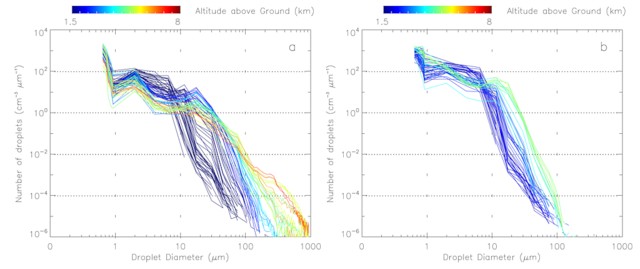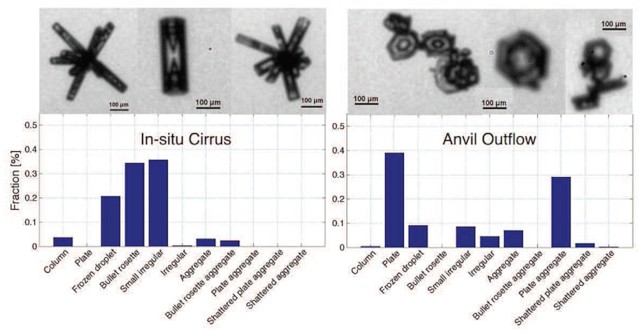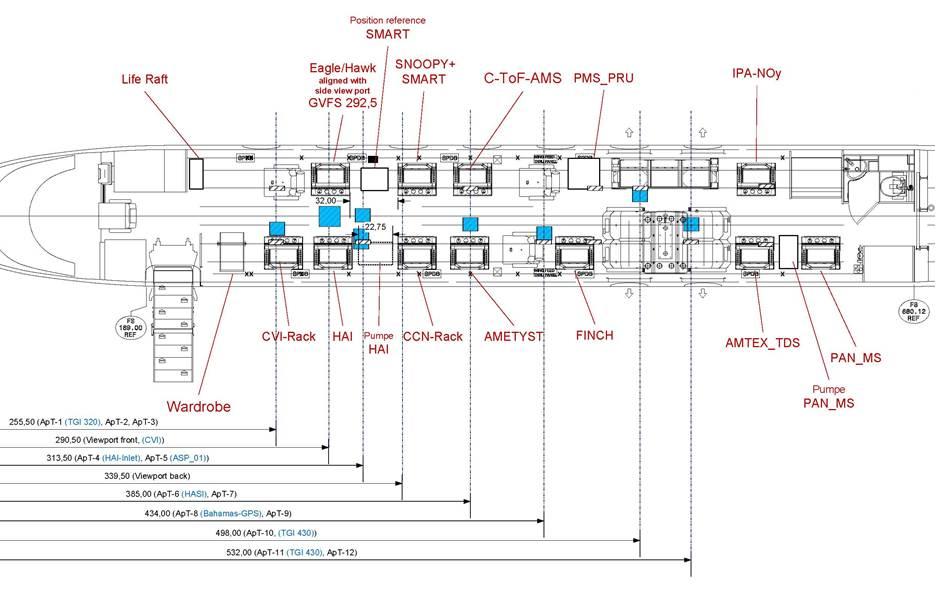ACRIDICON-CHUVA
Aerosol, Cloud, Precipitation, and Radiation Interactions and Dynamics of Convective Cloud Systems
Cloud processes of the main precipitation systems in Brazil: A contribution to cloud resolving modeling and to the GPM (GlobAl Precipitation Measurement)
Mission status: CompletedPersons in Charge
Mission Pi
- Meinrat O. Andreae (Max Planck Institute for Chemistry, Mainz)
- Manfred Wendisch (Leipzig University)
- Ulrich Pöschl (Max Planck Institute for Chemistry, Mainz)
Contact point at DLR-FX for this mission:
Contact point at DLR-FX for this mission:
HALO Project Management: Andreas Minikin
HALO Project Management: Katrin Witte
Postal address:
DLR Oberpfaffenhofen
Flugexperimente (FX)
Münchener Str. 20
82234 Weßling
Germany
Office phone:
+49 (0)8153 28-2538
HALO Deployment Base
HALO was operated from two bases during this campaign:
Time Period
Jun 16, 2014 – Oct 10, 2014
| Mission phase | Dates |
|---|---|
| Flight testing for HALO exterior configuration | 16 Jun 2014 - 4 Jul 2014 |
| Instrument integration, EMI tests, functional testing | 7 Jul 2014 - 29 Aug 2014 |
| Mission phase | 1 Sep 2014 - 4 Oct 2014 |
| Dismounting of payload | 5 Oct 2014 - 10 Oct 2014 |
Project description
ACRIDICON was planned as an extensive measurement campaign to study tropical convective clouds with focus on the Amazon rainforest. HALO was based in Manaus (Brazil, Amazonas State) from 1 September to 4 October 2014. The campaign was scheduled such that ACRIDICON could be combined with the ground-based CHUVA and the US GOAmazon (Green Ocean Amazon, second Intensive Operational Phase) projects.
In particular, ACRIDICON aimed at the quantification of aerosol-cloud-precipitation interactions and their thermodynamic, dynamic and radiative effects in convective cloud systems by in-situ aircraft observations and indirect measurements (aircraft, satellite, and ground-based). HALO carried out 14 research flights (96 flight hours in total). HALO was equipped with remote sensing and in-situ instrumentation for meteorological, trace gas, aerosol, cloud, and precipitation measurements.

Five mission objectives were pursued:
- cloud vertical evolution (cloud profiling),
- aerosol processing (inflow and outflow),
- satellite validation,
- vertical transport and mixing (tracer experiment),
- clouds over forested and deforested areas.
The five cloud missions collected data in clean atmospheric conditions and in contrasting polluted (urban and biomass burning) environments. For more detailed information we refer to the unpublished White Paper of ACRIDICON-CHUVA. An overview paper appeared of the ACRIDICON-CHUVA campaign appeared in the October 2016 issue of BAMS.
ACRIDICON attempted to answer the following general scientific questions:
- Does the interaction of natural and anthropogenic aerosols with clouds and precipitation significantly influence the cloud microphysics, the formation, evolution and dynamics of convective cloud systems and the vigor of heavy weather events (hail and rainstorms)?
- What are the characteristic physical and chemical properties of aerosol and cloud particles in convective cloud systems (inflow, in-cloud, outflow), and how do they change in the course of cloud evolution?
- What are the effects of convective cloud systems on the solar and terrestrial radiation budget, and how can the three-dimensional microphysical structure of convective clouds be considered?
- Are the cloud processes over rain forest and deforested regions statistically different?
More specifically the following questions are asked:
- What are the particle characteristics (number concentration, size distribution, structure, phase, composition, mixing state, cloud condensation and ice nucleation activity) as a function of height above cloud base and cloud base temperature and aerosol loading?
- Do the aircraft indirect and remote sensing measurement instruments and the available radar and satellite data allow to determine microphysical profiles of convective clouds as measured in situ by instruments mounted on the aircraft?
- How large are the characteristic differences in the microphysical (proportions and particle size distribution of liquid cloud droplets and ice crystals, liquid water and ice water profiles, precipitation intensity) and macrophysical (cloud areal and vertical extent) properties, dynamics (updraft velocities, turbulence), and radiative (albedo) effects of convective cloud systems in polluted and unpolluted air?
- Do air pollutants, in particular anthropogenic aerosol particles, significantly change the height and time for onset and properties of precipitation in convective cloud systems?
- How do deep convective clouds influence the aerosol particle and trace gas distribution below the cloud and in the free and upper troposphere (transport, source, and sink)?
The instruments installed on HALO during ACRIDICON covered a wide range of parameters. Basic meteorological and aircraft technical parameters have been observed. The radiation sensors detected solar radiances and irradiances with different spectral coverage and resolution. A suite of chemical sensors detected trace gas and aerosol particle chemical properties. Microphysical parameters were extensively measured covering the size range from 5 nm aerosol particles to 6.4 ?m precipitation elements, thus, spanning almost seven orders of magnitude. Inlets for cloud elements, aerosol particles, trace gases supply a number of instruments in the cabin of HALO. Several of the instruments are measuring the same or comparable quantities in overlapping ranges to guarantee high quality data.
Figure 1 shows an exemplary result of size distribution measurements collected in convective clouds at different height levels under different pollution levels of the environmental air. Figure 1a was taken in clouds developing in pristine conditions, whereas the cloud measurements plotted. In Figure 1b were collected in clouds evolving in smoky (biomass burning) conditions. The cloud drop concentration in the clean clouds is low (Figure 1a) and decreases fast further with height due to coalescence (not shown here), whereas cloud drop concentration is high and does not decrease with height due to suppressed coalescence in the smoky case (Figure 1b). The figures also show that the clouds grow slowly with height in the polluted case. In the pristine case cloud drops grow into the mm-size range and form rain (Figure 1a); in the smoky case (Figure 1b) cloud drops do not coalesce and form precipitation size drops in negligible amounts only.

Figure 1. Measured number size distributions in clouds from NIXE-CAPS instrument

Figure 2. Statistical analysis of the ice microphysical properties in an anvil outflow of a tropical convective system (right) and ambient in-situ cirrus (left). The analysis is based on stereoscopic images taken by the PHIPS-HALO probe.
Figure 2 is another example of the novelty of data that were collected during ACRIDICON-CHUVA. Using data from the new Particle Habit Imaging and Polar Scattering Probe (PHIPS) it was demonstrated that the microphysical properties of ice particles in anvil outflows of convective cloud systems differ significantly from that of ambient in-situ cirrus. While in-situ cirrus is dominated by small ice particles, bullet rosettes and bullet rosette aggregates, anvil outflows are largely composed of plates and plate aggregates.
This result clearly reflects the strong vertical transport that is prevailing in tropical convective systems. Plate-like ice crystals that were nucleated and grown in the lower, warmer parts of the system (> -37 °C) are lifted to the cold outflows (< -50 °C) where they are mixed with in-situ grown columnar crystals. Further analyses are currently being conducted to reveal the role of aerosol pollution to the ice microphysics in the outflow region.
Partners
- Max Planck Institut for Chemistry, Mainz
- Leipzig University
- Instituto Nacional de Pesquisas Espaciais (INPE), San Jose dos Campos, Brazil
- German Aerospace Center, Institute of Atmospheric Physics (DLR-IPA)
- Hebrew Univ. Jerusalem
- University of Sao Paulo (USP), Brazil
- University of the State of Amazonia (UEA), Manaus, Brazil
- Johannes Gutenberg University Mainz
- Goethe University Frankfurt
- Heidelberg University
- Ludwig-Maximilians-Universität München (LMU)
- Leibniz Institute for Tropospheric Research (TROPOS), Leipzig
- Karlsruhe Institute of Technology (KIT)
- Forschungszentrum Jülich (FZ Jülich)
- PTB Braunschweig (National Metrology Institute)
Scientific instruments and payload configuration
List of scientific instruments for the mission:
| Scientific instrument acronym | Description | Principal investigator | Institution |
|---|---|---|---|
| BAHAMAS | HALO Basic Data Acquisition System | Andreas Giez | DLR-FX |
| CVI | Inlet for Cloud Particles and Residues of size 5-30 µm | Stephan Mertes | TROPOS |
| HASI | Submicrometer Aerosol Inlet for aerosols of size < 1 µm | Daniel Sauer | DLR-IPA |
| TGI | Trace Gas Inlet | ||
| AMETYST (Aerosol MEasuremenT SYSTem) | Particle Concentrations and Size Distributions of Total and Non-volatile Aerosol 5-300 nm and 250 nm-3µm, Aerosol Absorption | Daniel Sauer | DLR-IPA |
| C-ToF-AMS (Compact Time-of-Flight Aerosol Mass Spectrometer) | Quantitative Mass Concentration of Non-refractory Aerosol Compounds of Aerosol Ensembles | MPIC | |
| CPC | Residual Particle Number Concentration, 10 nm - 3 µm | Stephan Mertes | TROPOS |
| PSAP | Residual Particle Absorption Coefficient, lambda = 567 nm | Stephan Mertes | TROPOS |
| UHSAS | Residual Particle Size Distribution, 60 nm - 1 µm | Stephan Mertes | TROPOS |
| Electrometer | Drop Charge | Stephan Mertes | TROPOS |
| FINCH (Fast Ice Nucleation CHamber) | Ice Nucleating Particles | Univ. Frankfurt | |
| CCN-Rack (CCN und SP-2) | CCN Concentration | MPIC | |
| SNOOPY (SiNgle-Particle SOOt Photometer SYstem) | Black Carbon Size Distribution, Particle Size Distribution 80-500 nm | DLR-IPA | |
| AENEAS (Atmospheric Nitrogen Oxides MEAsuring System) | NO, NOy, 5 pmol/mol - 60 nmol/mol | DLR-IPA | |
| AMTEX | Carbon Monoxide, Ozone, Perfluorocarbons | Hans Schlager | DLR-IPA |
| HAI (Hygrometer for Atmospheric Investigations) | Water Vapor | PTB, FZ Jülich | |
| ITMS | PAN, Organic Acids, SO2, HNO3 | DLR-IPA | |
| PERTRAS | PFCs, Perfluorocarbon | Hans Schlager | DLR-IPA |
| specMACS | Cloud Side Reflected Radiances | Tobias Zinner | Univ. München (LMU), Leipzig Univ., MPIC |
| miniDOAS (mini Differential Optical Absorption Spectroscopy) | 2D Detection of UV/visible/nearIR Absorbing Gases in Nadir and Scanning Limb Observation Modes | Denis Pöhler | Univ. Heidelberg |
| SMART (Spectral Modular Airborne Radiation Measurement System) | Spectral Irradiance (Up- and Downward), Spectral Radiance (Upward) | André Ehrlich | Leipzig Univ. |
| CAS-DPOL (Cloud and Aerosol Spectrometer with Detector for POLarization, PMS-Probe) | Aerosol, Cloud Droplet or Ice Crystal Concentration and Size Distribution, 0.6-50µm; Backscatter Polarization, Cloud Liquid Water Content | Daniel Sauer | DLR-IPA |
| CCP (Cloud Combination Probe, PMS-Probe) | Concentration and Size of Aerosol Particles, Cloud Droplets or Ice Crystals, 3.0-50 μm, 15 μm-0.9 mm | Stephan Borrmann | Univ. Mainz, MPIC |
| Hotwire LWC | Cloud liquid water content, 0.01 – 3 g m-3 | DLR-IPA | |
| MTP (Microwave Temperature Profiler, PMS-Probe) | Passive Microwave Radiometer Measuring the Natural Thermal Emission of Oxygen at 3 Frequencies | Mareike Kenntner | DLR-IPA |
| NIXE-CAPS (Novel Ice Experiment- Cloud and Aerosol Spectrometer, PMS-Probe) | Concentration and Size of Aerosol Particles, Cloud Droplets or Ice Crystals, 0.5-50 μm, 15 μm-0.9 mm, Backscatter Polarization | Martina Krämer | FZ Jülich |
| PCASP-100X (Passive Cavity Aerosol Spectrometer Probe, PMS-Probe) | Aerosol Particle Concentration and Size Distribution, 120nm-3µm | Daniel Sauer | DLR-IPA |
| PHIPS (Particle Habit Imaging and Polar Scattering Probe, PMS-Probe) | Cloud Droplets or Ice Crystal Size Distribution, 5-800 μm, Scattering Phase Function, Particle Shape, 3D Morphology | Martin Schnaiter | KIT |
| PIP (Precipitation Imaging Probe, PMS-Probe) | Large Cloud Droplet or Ice Crystal Size Distribution, 100 μm- 6 mm | Stephan Borrmann | Univ. Mainz, MPIC |
| SID-3 (Small Ice Detector, PMS-Probe) | Aerosol Particle, Cloud Droplet and Ice Crystal Concentration and Size, 2-140 μm, Particle Shape | Martin Schnaiter | KIT |
| UHSAS-A (Ultra-High Sensitivity Aerosol Spectrometer, PMS-Probe) | Aerosol Particle Concentration and Size Distribution, 60nm-1µm | Daniel Sauer | DLR-IPA |
Cabin and exterior configuration of HALO for the mission

HALO cabin layout for ACRIDICON-CHUVA



HALO exterior configuration for ACRIDICON-CHUVA
Halo flights for this mission
| Aircraft registration | Date | Take off - Landing / UT | Total flight time / h | From - To | Mission # |
|---|---|---|---|---|---|
| D-ADLR | 2014-06-27 | 09:50:00 - 11:30:00 | 1.667 | EDMO - EDMO | Flight test |
| D-ADLR | 2014-08-21 | 14:00:00 - 15:40:00 | 1.667 | EDMO - EDMO | Flight test |
| D-ADLR | 2014-08-22 | 11:00:00 - 13:10:00 | 2.167 | EDMO - EDMO | Flight test |
| D-ADLR | 2014-08-24 | 11:30:00 - 13:45:00 | 2.250 | EDMO - EDMO | Flight test |
| D-ADLR | 2014-08-27 | 08:30:00 - 11:40:00 | 3.167 | EDMO - EDMO | Flight test |
| D-ADLR | 2014-08-27 | 12:40:00 - 14:50:00 | 2.167 | EDMO - EDMO | Flight test |
| D-ADLR | 2014-09-01 | 10:00:00 - 16:10:00 | 6.167 | EDMO - GVAC | Transfer/Mission flight |
| D-ADLR | 2014-09-02 | 15:00:00 - 21:55:00 | 6.917 | GVAC - SBEG | Transfer/Mission flight |
| D-ADLR | 2014-09-06 | 16:05:00 - 23:25:00 | 7.333 | SBEG - SBEG | Mission flight |
| D-ADLR | 2014-09-09 | 15:05:00 - 20:20:00 | 5.250 | SBEG - SBEG | Mission flight |
| D-ADLR | 2014-09-11 | 14:25:00 - 20:20:00 | 5.917 | SBEG - SBEG | Mission flight |
| D-ADLR | 2014-09-12 | 15:00:00 - 22:10:00 | 7.167 | SBEG - SBEG | Mission flight |
| D-ADLR | 2014-09-16 | 14:40:00 - 21:50:00 | 7.167 | SBEG - SBEG | Mission flight |
| D-ADLR | 2014-09-18 | 14:50:00 - 20:50:00 | 6.000 | SBEG - SBEG | Mission flight |
| D-ADLR | 2014-09-19 | 14:55:00 - 21:10:00 | 6.250 | SBEG - SBEG | Mission flight |
| D-ADLR | 2014-09-21 | 15:05:00 - 22:05:00 | 7.000 | SBEG - SBEG | Mission flight |
| D-ADLR | 2014-09-23 | 10:30:00 - 17:35:00 | 7.083 | SBEG - SBEG | Mission flight |
| D-ADLR | 2014-09-25 | 14:35:00 - 21:10:00 | 6.583 | SBEG - SBEG | Mission flight |
| D-ADLR | 2014-09-27 | 14:05:00 - 20:30:00 | 6.417 | SBEG - SBEG | Mission flight |
| D-ADLR | 2014-09-28 | 14:40:00 - 21:15:00 | 6.583 | SBEG - SBEG | Mission flight |
| D-ADLR | 2014-09-30 | 15:00:00 - 22:00:00 | 7.000 | SBEG - SBEG | Mission flight |
| D-ADLR | 2014-10-01 | 15:00:00 - 21:50:00 | 6.833 | SBEG - SBEG | Mission flight |
| D-ADLR | 2014-10-03 | 12:15:00 - 19:10:00 | 6.917 | SBEG - GVAC | Mission flight |
| D-ADLR | 2014-10-04 | 10:00:00 - 16:05:00 | 6.083 | GVAC - EDMO | Mission flight |
HALO flight tracks
More information
Scientific background and links to more information:
- ACRIDICON-CHUVA homepage by the Univ. Leipzig
- ACRIDICON-CHUVA webpage by MPI für Chemie
- ACRIDICON-CHUVA overview paper: Wendisch et al. (2016)
- CHUVA webpage: [in Portuguese] | [in English]
- GoAmazon webpage
Campaign reports and stories:
- ACRIDICON-CHUVA blog by M. O. „Andi“ Andreae
Overview paper of ACRIDICON-CHUVA in the Bulletin of the American Meteorological Society.
Press releases, media etc
DLR press release, 7-Oct-2014
Climate research with HALO over the Brazilian rainforest. Thunderclouds over rainforests are an important element in the climate system. The German Aerospace Center (Deutsches Zentrum für Luft- und Raumfahrt; DLR) research aircraft HALO spent the period from the beginning of September to the beginning of October 2014 in Manaus, a city in the Brazilian state of Amazonas, measuring the emergence, development and properties of tropical clouds. The ACRIDICON (Aerosol, Cloud, Precipitation, and Radiation Interactions and Dynamics of Convective Cloud Systems) researchers launched the mission to better understand the microphysical mechanisms that prevail within these towering clouds and that determine their climate impact. Additionally, the researchers investigated the means by which trace substances are transported up through the clouds and how vegetation fires influence cloud properties and precipitation. The Max Planck Institute for Chemistry (MPIC) and the University of Leipzig were responsible for the scientific management of the project. In total, 23 academic institutions were involved in the HALO flight campaign. Read more.. (in English) | Weiterlesen.. (auf deutsch)
Publications
Emma Järvinen, Martin Schnaiter, Guillaume Mioche, Olivier Jourdan, Valery N. Shcherbakov, Anja Costa, Armin Afchine, Martina Krämer, Fabian Heidelberg, Tina Jurkat, Christiane Voigt, Hans Schlager, Leonid Nichman, Martin Gallagher, Edwin Hirst, Carl Schmitt, Aaron Bansemer, Andy Heymsfield, Paul Lawson, Ugo Tricoli, Klaus Pfeilsticker, Paul Vochezer, Ottmar Möhler, and Thomas Leisner. Quasi-Spherical Ice in Convective Clouds. J. Atmos. Sci., 73, 3885–3910, doi:10.1175/JAS-D-15-0365.1, 2016.
Manfred Wendisch, Ulrich Pöschl, Meinrat O. Andreae, Luiz A. T. Machado, Rachel Albrecht, Hans Schlager, Daniel Rosenfeld, Scot T. Martin, Ahmed Abdelmonem, Armin Afchine, Alessandro Araùjo, Paulo Artaxo, Heinfried Aufmhoff, Henrique M. J. Barbosa, Stephan Borrmann, Ramon Braga, Bernhard Buchholz, Micael Amore Cecchini, Anja Costa, Joachim Curtius, Maximilian Dollner, Marcel Dorf, Volker Dreiling, Volker Ebert, André Ehrlich, Florian Ewald, Gilberto Fisch, Andreas Fix, Fabian Frank, Daniel Fütterer, Christopher Heckl, Fabian Heidelberg, Tilman Hüneke, Evelyn Jäkel, Emma Järvinen, Tina Jurkat, Sandra Kanter, Udo Kästner, Mareike Kenntner, Jürgen Kesselmeier, Thomas Klimach, Matthias Knecht, Rebecca Kohl, Tobias Kölling, Martina Krämer, Mira Krüger, Trismono Candra Krisna, Jost V. Lavric, Karla Longo, Christoph Mahnke, Antonio O. Manzi, Bernhard Mayer, Stephan Mertes, Andreas Minikin, Sergej Molleker, Steffen Münch, Björn Nillius, Klaus Pfeilsticker, Christopher Pöhlker, Anke Roiger, Diana Rose, Dagmar Rosenow, Daniel Sauer, Martin Schnaiter, Johannes Schneider, Christiane Schulz, Rodrigo A. F. de Souza, Antonio Spanu, Paul Stock, Daniel Vila, Christiane Voigt, Adrian Walser, David Walter, Ralf Weigel, Bernadett Weinzierl, Frank Werner, Marcia A. Yamasoe, Helmut Ziereis, Tobias Zinner, Martin Zöger. The ACRIDICON-CHUVA campaign: Studying tropical deep convective clouds and precipitation over Amazonia using the new German research aircraft HALO. Bull. Amer. Meteor. Soc., doi:10.1175/BAMS-D-14-00255.1, 2016.
